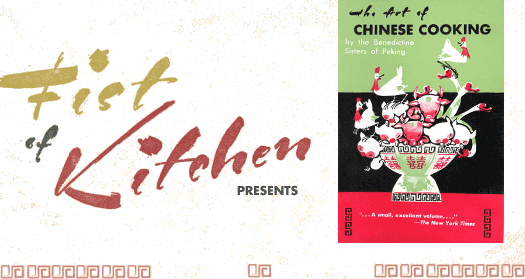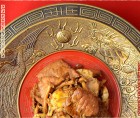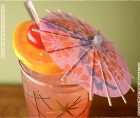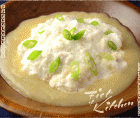
We're cooking, in its entirety, an inadvisable out-of-print Chinese cookbook, written for a very limited 1956-American palate. Why? We found this book in our mom's Goodwill pile. We immediately adopted it—the adorable illustrations which decorate every page made it irresistable. But then…we began to read about the lives of its authors, their allies, and their enemies.
In 1930, eight Benedictine Sisters from a convent in Minnesota set out for Kaifeng, China to set up schools and medical facilities. These were women who grew up in the harshness of the American Midwest in the late 1890s, early 1900s. Think Laura Ingalls Wilder. Now think about how different pre-industrial China was from "luxuries" of rural Midwestern America at the time—not very. These missionaries were hearty people. But climate was not the Sisters' only adversary.
It was a period of both civil and external war. In short summary: the fall of the Qing Dynasty left a power vacuum, and the Nationalists and Communists were fighting to take over. In this incohesive state, local authority was claimed by regional warlords. Their vassals were much-feared bandits who patrolled the roads (possibly hoping to pick up a fat missionary priest for a handsome ransom from his parish back home). Meanwhile Mao, Zhou Enlai and the Red Army were on their famous "Long March," being chased nearly 3700 miles by the Nationalist Army of Chiang Kai-Shek. Notably, Chiang was Christian, and adopted some Western values, while the Communists were Anti-Western and atheist. Chiang won the nominal support of the United States, who committed arms and training under General Joeseph Stilwell. Stilwell didn't do much good for diplomacy—they called him "Vinegar Joe," and he called them names that would end a TV career today.
Unsurprisingly, missionaries occupied a controversial identity in China. They were partially cited as a cause of the Boxer Rebellion. At the same time they established schools, medical dispensaries and hospitals—social services that were of little interest to governing warlords. Also, American missionaries often acted as quasi-diplomats; however, their American-ness was a bit of a question. To the Chinese, they were Italian foremost. To the Japanese, when at war with the US, they were American. The Sisters served alongside two orders of priests from Germany and Italy. Depending on which countries were at war with one another, they would use one another's nationality for protection.
A friend of the Sisters, Father Cesare Mencattini describes the scene in Kaifeng:
Immense populations live here in desolation and misery. We missionaries could not reach everyone even if we had wings...The inhabitants of those areas are reduced to the most extreme poverty, the results of brigands' passing, war, and the flooding of the Yellow River. Along the roads you see groups of vagabonds, who don't even have a hole in which to spend the night nor sufficient clothes to guard against cold, which is so intense here in Henan...we also have the feeling of being alone in the midst of these people who regard us with indifference and disdain. We're often the objects of insulting words, "here comes a European dog..."
When Japan invaded a weakened China in 1937, thus starting the second Sino-Japanese war, it was inevitable that Kaifeng would be taken. The Sisters spent the duration of the war in a Japanese internment camp—which they were forced to run out of their own school—under horrible conditions. When the war ended, it seemed for a short time that peace would hold: the warring Nationalists and Communists had banded together to fight against the Japanese. No such luck. When the Communists prevailed, they tossed all of the missionaries out of the country. (Chinese Christians were a LOT less lucky). The Sisters went to Formosa (Taiwan)—where Chiang Kai-Shek himself had been driven—and then set out for Tokyo in 1952. They found themselves rather broke, so they took the Chinese cooking knowledge they had gained over the last 20 years and established a cooking school. Nine years later, The Art of Chinese Cooking was published in the United States, and went into 41 reprints. On its cover, The New York Times calls it "A small, excellent volume." Interestingly, one quote featured on the back is from the Air Force Times, appealing to the wives of soldiers returning to the United States: "Finally a cookbook has appeared that is the answer to a wife's dream and every husband's epicurean prayer."
So, as I was saying....Goodwill pile, cute illustrations... we had to cook the book, and here we are.
What's curious to us (or maybe obvious) about the recipes is that they are so bare-bones as to be the least one could do. The most exotic ingredients are ginger and soy sauce. Some recipes are indistinguishable from one another, save for the vegetable. Is this exemplary of the wartime conditions, and persistent poverty and starvation, under which it was conceived? Or is it that Boston food editors in 1956 Anglified the recipes so much, that only the base ingredients remained? 5-spice power, hoisin sauce, chili sauce, Sichuan pepper, star anise, oyster sauce, dried seafood, anything-that-can-be-fermented—staples of the Chinese kitchen—are missing. We hope to solve this mystery, and meanwhile we'll be introducing new ingredients and reporting on our taste tests to find the best brands.
The original book was illustrated by M. Nakamura. She/He's awesome. The illustrations on every page make this such a nice book to look at—at a time when cookbook photography would more likely induce indigestion than appetite. We of course can't use the original illustrations, but that's a perfect excuse for me to draw something every day without having to wonder what I'll draw—of course it will be a cow, a pig, a chicken, or a fish. Artist's dilemma solved.
In addition to the food, we'll be reporting from the past with notes, stories and letters from the sisters, their friends and even their enemies. Not a comprehensive history, just little portholes into the past.
So as they say in China, 胃口好! Well, they probably don't...but anyway, thanks Google Translate.
A good appetite to all of you.
—Matt
 Polynesian Spell
Polynesian Spell  pork, egg, and mushrooms
pork, egg, and mushrooms  Singapore Sling
Singapore Sling  pork with celery
pork with celery  Chicken Velvet
Chicken Velvet 